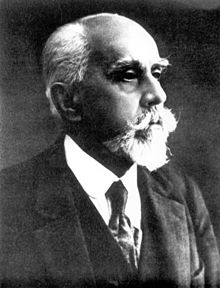Stefan Drzewiecki
Stefan Drzewiecki | |
|---|---|
 Stefan Drzewiecki | |
| Born | July 26, 1844 Kunka |
| Died | April 23, 1938 (aged 93) |
| Nationality | Polish |
| Occupation | Engineer, constructor and inventor |
| Known for | Submarine design |
Stefan Drzewiecki (Russian: Джеве́цкий Степа́н Ка́рлович (Казими́рович); 26 July 1844, Kunka, Podolia, Russian Empire (today Ukraine) – 23 April 1938, Paris) was a Polish scientist, journalist, engineer, constructor and inventor, working in France and the Russian Empire.[1][2][3] He built the first submarine in the world with electric battery-powered propulsion (1884).
Life[]
Drzewiecki was born into Polish aristocratic (szlachta) family of national patriots. His grandfather Józef Drzewiecki served under generals Kościuszko and Dąbrowski. His father Karol Drzewiecki took part in the November Uprising against Russia. Young Stefan was sent by him away from partitioned Poland to complete his education in France. At the beginning of 1860. Drzewiecki was admitted to , however he postponed finishing his engineering studies to take part in January Uprising (1863-1864) against Russia. A few years later, he came back to Paris to finish his study. With a knack for creativity and invention, Stefan Drzewiecki invented such useful tools as the kilometric counter for taxicabs. At the special request of Grand Duke Konstantin, Drzewiecki moved to Saint Petersburg in 1873 at the age of 29. While in Russia Drzewiecki had a fruitful career as a mechanical engineer.
Career[]

Drzewiecki distinguished himself mainly in aviation and ship building. Beginning in 1877, during the Russo-Turkish War, he developed several models of propeller-driven submarines that evolved from single-person vessels to a four-man model.
In 1884, he converted 2 mechanical submarines, installed on each a 1 hp engine with the new, at the time, source of energy - batteries. On tests submarine went under the water against the flow of the Neva River, Russia at a rate of 4 knots. It was the first submarine in the world with electric battery-powered propulsion.[4]
He developed the theory of gliding flight, developed a method for the manufacture of ship and plane propellers (1892), and presented a general theory for screw-propeller thrust (1920). He also developed several models of early submarines for the Russian Navy, and devised a torpedo-launching system for ships and submarines that bears his name, the Drzewiecki drop collar. He also made an instrument that drew the precise routes of ships onto a nautical chart.[3][5]
His work Theorie générale de l'hélice (1920), was honored by the French Academy of Science as fundamental in the development of modern propellers.
See also[]
 Media related to Stefan Drzewiecki at Wikimedia Commons
Media related to Stefan Drzewiecki at Wikimedia Commons
- Blade element theory designed by William Froude (1878), David W. Taylor (1893) and Stefan Drzewiecki to determine the behavior of propellers.
Notes[]
- ^ Branfill-Cook, Roger (2014). Torpedo: The Complete History of the World's Most Revolutionary Naval Weapon. Seaforth Publishing. p. 117. ISBN 9781848322158.
- ^ Gudmundsson, Snorri (2013). General Aviation Aircraft Design: Applied Methods and Procedures. Butterworth-Heinemann. p. 640. ISBN 9780123973085.
- ^ Jump up to: a b „Drzewiecki” submarine at CTIE.Monash.edu.au.
- ^ Magazine, Hakai. "Stefan Drzewiecki, Submarine Tsar | Hakai Magazine". Hakai Magazine. Retrieved 2018-03-07.
- ^ Okręty Podwodne Świata (wszystko o okrętach podwodnych). at OPS.Mil.pl
References[]
- Słownik polskich pionierów techniki pod redakcją Bolesława Orłowskiego. Katowice: Wydawnictwo „Śląsk”, 1986, s. 57. ISBN 83-216-0339-4.
- Alfred Liebfeld, Polacy na szlakach techniki. Warszawa: Wydawnictwa Szkolne i Pedagogiczne, 1985, s. 215–225. ISBN 83-02-01574-1.
- Krzysztof Kubiak, Wielki błękit wynalazców, biuletyn „Rzeczpospolitej” 11 grudnia 2010, Nr 47
- Jerzy Pertek, Polscy pionierzy podwodnej żeglugi, seria wydawnicza Wydawnictwa Morskiego Miniatury Morskie zeszyt 3: Polskie tradycje morskie, s. 26–49.
- 1844 births
- 1938 deaths
- Polish inventors
- Polish engineers
- Recipients of the Cross of St. George
- Submarine pioneers
- Marine engineers
- People from Haisyn Raion